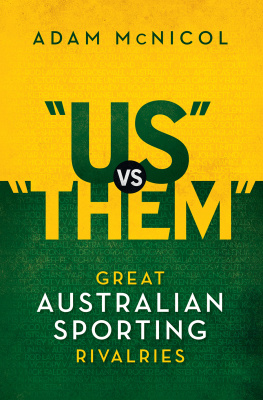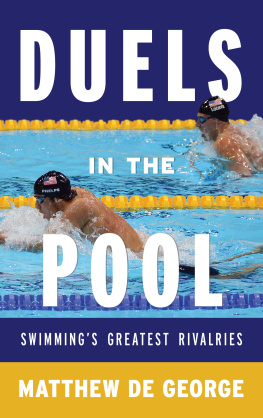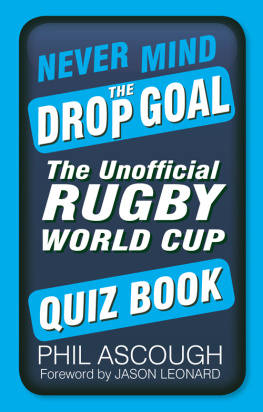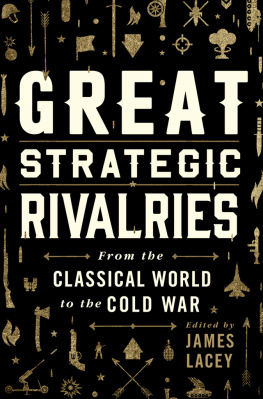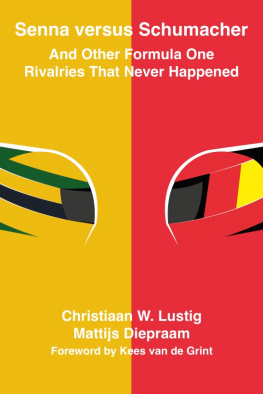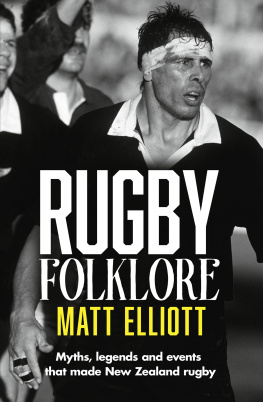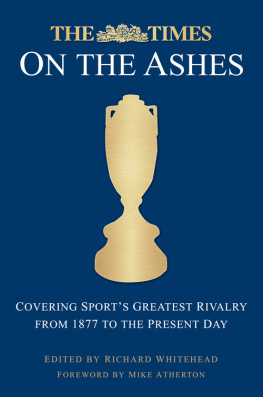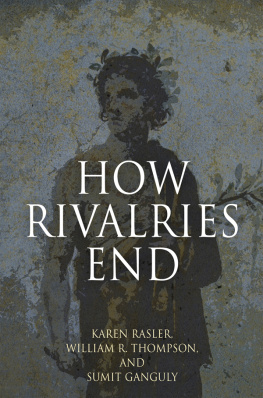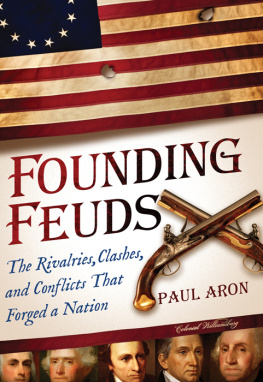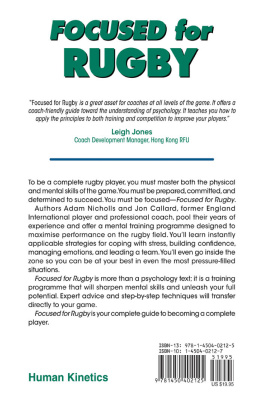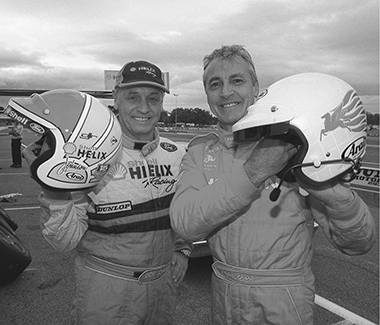Thanks firstly to Craig Collins, key account manager at The Five Mile Press, for coming up with the idea of a book about Australian sporting rivalries, and to commissioning editor Julia Taylor for giving me the opportunity to bring Craigs idea to life. My ever-supportive wife, Zara, played a key role in assisting with the research (she nearly wore out her library card!) and bringing the manuscript up to standard, while Julian Welch did a brilliant job with the editing. A number of my colleagues at AFL Media also came forth with some excellent suggestions on which rivalries to include and why. All the help was greatly appreciated.
Adam McNicol is a Ballarat-based journalist and author. He has written a number of books, including The Danihers , the authorised biography of the four brothers who played for Essendon, and Manangatang , a social history of the iconic town in northern Victorias Mallee region. He has also co-written All Bets Are Off , the autobiography of former Melbourne AFL player and reformed gambler David Schwarz, and In My Own Words , the autobiography of former Carlton and Brisbane Lions AFL star Brendan Fevola. Along with writing books, Adam is a reporter at AFL Media, where he works on the Australian Football Leagues official website, afl.com.au, and its match-day magazine, the AFL Record .
Racing drivers Dick Johnson and Peter Brock were fierce rivals for more than three decades. During most of that time, Johnson was Fords main man and Brock was Holdens pin-up boy.
MOTORSPORT
Holden vs Ford
If you strike up a conversation with a few passionate Holden or Ford fans in your local pub, they might bend your ear with some considered points of debate such as these:
What do you call a Ford at the top of a hill? A mirage.
What do you call two Fords at the top of a of a hill? A miracle.
What do you get if you cross an Aussie with a lawnmower? A Holden.
Whats the difference between a Holden and an elephant? One is big and slow and the other is an elephant.
Those jokes might seem rather silly to people who are not interested in cars or in watching others drive cars at high speed around famous racetracks such as Bathurst and Sandown but the fact that there are countless websites dedicated to them demonstrates the parochial nature of the Holden and Ford rivalry, which has dominated Australian motorsport for more than six decades.
The rivalry began away from the racetracks, in the early 1900s, when General Motors and Ford, two of the biggest American car manufacturers, began to make their presence felt Down Under. In the early years both GM and Ford exported fully built cars from North America to Australia, but they soon came to the conclusion that building cars in Australia would be cheaper and would allow for the development of vehicles better suited to Australian conditions. GM initially did a deal with an Adelaide-based operation called Holden Motor Body Builders, which eventually led to a merger and the formation of the General Motors Holden business that we know today (its cars have sported the simple Holden name since the merger in 1931). In contrast, Ford started a new business of its own, Ford Australia, and built a state-of-the-art factory in Victorias second-largest city, Geelong. The move inspired GMH to respond by building its own factory at Fishermans Bend, in Melbournes inner south.
During their early years of operation, both factories assembled cars from parts made overseas. But soon after the end of the Second World War, the federal government set about trying to create a race among carmakers to build the first Australian car a vehicle not only assembled in Australia but also constructed from locally made parts. General Motors Holden won the highly publicised race in a canter. As Steve Bedwell has written in Holden versus Ford: The Cars, the Culture, the Competition : On 29 November 1948, with 18,000 advance dealer orders held sight unseen, the Holden 48-215 was revealed to 1000 invited guests at Fishermans Bend. Forty-four radio stations broadcast [Prime Minister] Ben Chifleys speech launching the Holden; his description must go down as the most famous words in Australian automotive history: Shes a beauty!
Holdens sales boomed after the release of its Australian-made vehicle, and by the mid-1950s it was leaving Ford in its wake. In response, Fords administrators, led by managing director Charlie Smith, launched a campaign to come up with a car that would capture the imagination of Aussie buyers. The car would be built at a new assembly plant in Broadmeadows, on Melbournes northern fringe.
To choose the design, Smith travelled to Fords global headquarters in the American city of Detroit, where he was shown a clay model of an updated version of the Zephyr, a vehicle that was being built and sold in the United Kingdom. However, as Smith later told motoring historian John Wright, When they wheeled out the Zephyr at the design studios, I simply didnt like the look of it, and I said so. Smith and his team of executives knew Ford was planning to release a new compact car to be known as the Falcon in North America, so they asked to see a model of it. Smith was immediately won over. Thats the car I want for Australia, he declared.
It proved to be a very wise choice. The first Falcon, the XK, was released in September 1960 and sold almost 70,000 units in around nine months. Although Holden sold more than 200,000 units of its FB and EK models during the same period, Ford was back in the game. Its rivalry with Holden was alive once more. Bedwell quoted a motoring writer of the day: For the first time since 1948, Australians are being offered the type of car they want without it having to be a Holden. The Falcon is a car designed for this year, unlike the Holden, which is a rehashed version of an already long established model.
Both Holden and Ford soon realised that being involved in motorsport and winning races, in particular could play a key role in their sales war. Both were won over by the win on Sunday, sell on Monday idea. The holy grail at the time, as it remains today, was the endurance race now known as the Bathurst 1000.
The race was initially held at Phillip Island, Victoria, and the original distance was 500 miles. Known in its early years as the Armstrong 500 (it was sponsored by Armstrong, a manufacturer of shock absorbers), the race was designed to test the speed, performance and reliability of Australian-built cars. As a result, the rules restricted entries to standard, unmodified saloons built or assembled in Australia. To put it simply, the early races did not involve purpose-built race cars. Rather, they were the exact vehicles that were on sale to the public in showrooms around the nation (although safety features, such as roll cages, were allowed to be fitted). The cars competed in four classes, which were based on the purchase price of the vehicle in Australian pounds.
The first Armstrong 500 was held on 20 November 1960. A large number of Holdens and Fords were entered, yet the race was won by a Vauxhall Cresta. A Mercedes Benz driven by Harry Firth and Bob Jane, who would both become legends of the sport won the following year. It was not until the third race, held in November 1962, that Ford landed the first blow in its emerging motorsport rivalry with Holden.
Ford had signalled its intention to take motorsport very seriously by forming its own team, which was listed in race programs as Ford Motor Co. of Australia. The team was formed early in 1962, with Jane and Firth, who served as both a driver and as team manager, among its first recruits. That year, the pair notched Fords first victory at Phillip Island, in an XL Falcon, in a record time of eight hours and 15 minutes.

